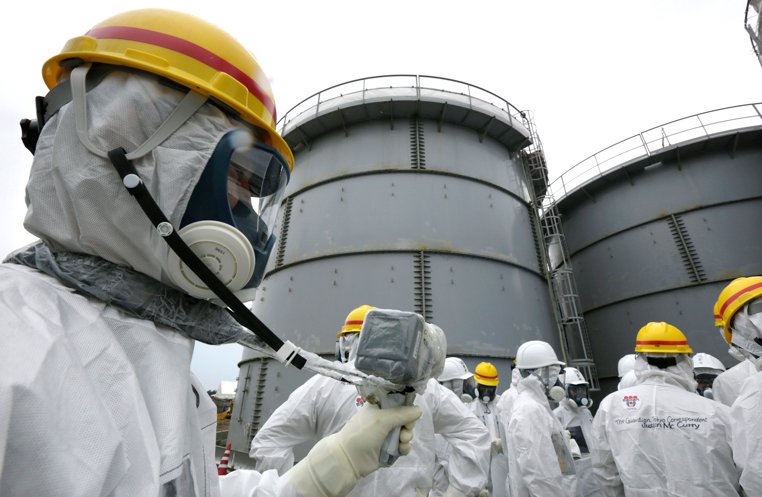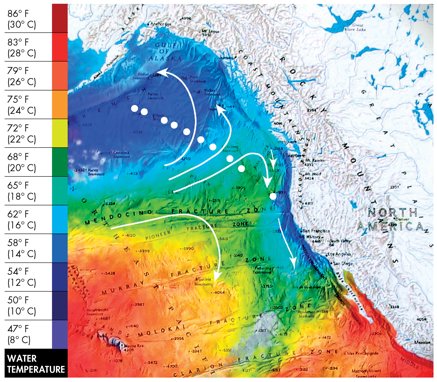
Fukushima: The Disaster Continues
The spring 2011 meltdown at the Fukushima Daiichi power plant in Japan is considered—with Chernobyl in 1986—one of the worst nuclear disasters in the history of the planet. Three of the plant’s reactors melted down after being hit by the tsunami caused by the magnitude 9 earthquake, spewing radioactive elements into the air and water. Many on North America’s West Coast were concerned about this radioactivity, and felt that government agencies weren’t doing nearly enough to monitor the situation.
Nuclear watchers are equally concerned about the Diablo Canyon nuclear plant in California, at the top of the earthquake-prone list, which Damon Moglen, a senior adviser to Friends of the Earth, describes as “a direct parallel to what was going on in Japan.”
These concerns led Northern California activist John Bertucci and associates to create Fukushima Response, a regional network of citizens working to spur stronger action against the threat of global radiation contamination from Fukushima. While many people assume that the situation has been contained, it has not. At least 300 tons (80,000 gallons) of radioactive wastewater have flowed from the Fukushima plant into the Pacific Ocean every day for nearly four years.
“The initial explosions were like flushing a toilet, but what we have is a faucet you can’t turn off. And that’s what nobody wants to confront,” Bertucci told Freedom.
“No question, this kind of truth is hard to embrace. Who wants to think about it?” Bertucci wrote in an update on the catastrophe. “We look around, things look the same and the media ‘helpfully’ reinforces that perception. Our opinions are guided into a polarized, false choice: those currently trying to talk about Fukushima in a coherent manner are framed as ‘alarmists’ and those who want us to believe that Fukushima is ‘no problem’ simply omit to mention the correct time frame for truly understanding what’s wrong there, the full span in which this disaster is going to play itself out.”
Because they view the Environmental Protection Agency and other government bodies actions as woefully inadequate, Bertucci and fellow citizen scientists have been doing their own radiation monitoring. Bertucci also points out that no U.S. government agency monitors radiation levels in ocean water.
“EPA does not monitor or sample ocean waters or operate outside of U.S. territories. We work with other federal agencies, including the National Oceanic and Atmospheric Administration (NOAA), the Food and Drug Administration (FDA), and the Nuclear Regulatory Commission (NRC) to carefully follow the situation at the Fukushima nuclear power plant,” responded the EPA to an email query regarding their efforts.
This is all part of what led Fukushima Response and partners to start a campaign in 2013 calling for the International Atomic Energy Agency (IAEA) to add a new “Level 8” designation to its International Nuclear Events Scale. This new level would “identify the urgent need for international assistance and monitoring” of an unprecedented situation like that at Fukushima, a “multi-unit, disaster-initiated and/or ongoing radioactive release requiring global response.”
Recent news reports have indicated that the radioactive plume from the Fukushima disaster is now hitting the North American West Coast, but will peak in the next year or two, and even at its peak, levels of contamination will be so low the public need not be concerned. But a growing voice of scientists and activists suggests that the radioactivity continuing to flow out of Fukushima remains a threat with potentially dire ramifications for humanity.
Said Friends of the Earth’s Moglen in a recent interview, “The problem is that Fukushima is an international disaster—they continue to pump vast quantities of nuclear waste into the open ocean, which is against the law. The IAEA is doing nothing about that. The United Nations is doing nothing about that. And yet there is a global treaty banning the dumping of nuclear waste at sea and nobody is saying Japan is in noncompliance.”
Why aren’t the Tokyo Electric Power Company (TEPCO) that runs the Fukushima power plant and the Japanese government doing more to contain the radioactive wastewater? Moglen said it boils down to economics.
“Of course they could store it. The problem here is the almighty greenback…. The fact of the matter is that they could do everything they could to actually retain that liquid and stop the spread of it into the ocean, but they don’t want to spend that kind of money,” Moglen said. He cited the 2010 BP oil spill with the U.S. government putting heavy pressure on BP to contain the spill, yet noted Fukushima has not received the same urgency.
“If we actually started spending hundreds of billions of dollars to deal with the Fukushima nuclear disaster, it would bankrupt the Japanese nuclear industry, which supposedly was one of the most together and most powerful in the world…. And if Japan goes under, people would start to ask what is the true cost of nuclear power?” Moglen said.
Fukushima Response’s Bertucci points to the nuclear power industry’s connection with the military as another related factor.
“The whole military-industrial complex is invested in nuclear, and the plants are the flip side of the coin. If you took away the nuclear power plants for electricity, it would be incredibly expensive for them to generate the plutonium they need for the bombs. The plants do that automatically, it’s a win-win for them. But Fukushima has changed the game,” Bertucci said.
Moglen pointed to public relations as a major culprit: “The nuclear industry has a multimillion-dollar PR budget and they are fighting for their lives. They are very focused on trying to minimize the sense that nuclear is dangerous.”
Kevin Kamps, radioactive waste watchdog for Beyond Nuclear, said it appears that “a cost-benefit decision” was reached regarding the roughly 300 tons per day of waste allowed to flow into the Pacific.
“It is deeply disturbing,” said Kamps by email. “The attitude seems to be that the ocean is a radioactive industrial sewer, to be used at whim by the nuclear power industry and pro-nuclear governments, like that of Prime Minister [Shinzo] Abe of Japan. This situation could become much more dire in the near future. … They want to dump the accumulated 100 million gallons stored in that tank farm into the ocean, and be done with it.”
Why is there still so much radioactive wastewater flowing out of the Fukushima plant and into the Pacific Ocean, so long after the meltdown? Kamps said that Tokyo Electric Power Company has to keep pumping water through the plant to cool down the melted cores.
“Tokyo Electric must continue to cool the melted cores for years. In a sense, it’s not unlike the irradiated nuclear fuel in a storage pool at a reactor site. In the U.S., some high-level radioactive waste is still stored in pools, a half-century after it left the reactor core as irradiated nuclear fuel. The thermal heat given off by the radioactive decay is so significant, it has to be continually cooled,” Kamps explained. “Fukushima Daiichi, of course, is an out-of-control catastrophe. So TEPCO has to continue to cool the melted cores in Units 1, 2 and 3, even though they don’t really know the status, or even location, of those three melted cores.”
Kamps warned that the volatile situation also includes factors that scientists are not able to measure, further heightening the need to contain the radiation.
“A diabolical move is afoot,” Kamps said. “TEPCO and Abe’s administration wish to release the 100 million gallons of radioactively contaminated wastewater… into the ocean. But there are some 200 radioisotopes contained in high-level radioactive waste, which is what the wastewater is contaminated with…. So what about those 140 or so other radioactive isotopes not being filtered out before release to the ocean?
“Science knows little to nothing about the potential biological impacts of those radioisotopes. The assumption that there is little or no biological hazard is not precautionary nor conservative.” Kamps said that American advisers have “shamefully” been hired by TEPCO to put an American nuclear industry stamp of approval on this dumping plan, including former Nuclear Regulatory Commission Chairman Dale Klein and former U.S. Department of Energy official Lake Barrett (who also directed cleanup efforts for the NRC at the Three Mile Island accident in 1979).
For a better solution than dumping the wastewater or storing it on site, Kamps cited a suggestion from Dr. Arjun Makhijani of the Institute for Energy and Environmental Research. Makhijani recommends pumping the captured radioactive water into the hold of a supertanker and transporting it to a safer and more stable location where the filtration process could be carried out.

As to why the United States hasn’t intervened further, Kamps cited a litany of conflict of interest issues between regulators, government and the industry they are supposedly tasked with overseeing.
Kamps cited Keith Baverstock, a British scientist who studies the health impacts of the 1986 Chernobyl nuclear meltdown, and who challenged the neutrality and scientific validity of the 2014 Fukushima report from the United Nations Scientific Committee on the Effects of Atomic Radiation. Released last April, the UNSCEAR report minimized the possibility of higher cancer rates developing as a result of the Fukushima disaster. Baverstock told the Asahi Shimbun newspaper in Japan that the report was “not qualified to be called ‘scientific’” because it lacked transparency and independent verification. He also said the committee should be disbanded.
Baverstock warned that the Fukushima crisis is far from over. “Radioactivity is still being discharged to the air and to the sea. … Some progress appears to have been made in removing radioactivity from the stored water on the site, but that does not include removing the tritium which will be discharged at sea when that water is released.”
There’s also growing concern about the potential for a Fukushima-level disaster on the American West Coast.
“The NRC did an evaluation of nuclear plants most likely to be hit with earthquakes stronger than they were built to withstand [as happened at Fukushima], and Diablo Canyon [in California’s San Luis Obispo County] was at the top of the list,” said Bill Walker, a campaign consultant for Friends of the Earth, in a phone interview.
The NRC evaluation of American nuclear facilities was conducted in 2011 after the Fukushima disaster. But whether the NRC really prioritizes the safety of Californians is debatable. In December 2014, Friends of the Earth issued a news release drawing attention to internal emails, acquired through a Freedom of Information Act request, indicating that the NRC and Pacific Gas & Electric Company had colluded to downplay the earthquake danger at Diablo Canyon.
“This is a new and shocking example of such collusion on an issue that could affect the safety of hundreds of thousands of lives,” said Moglen in the news release. “Rather than acting to address the fact that PG&E is operating Diablo Canyon without a valid license and in a place where no reactors belong, the NRC has sought to protect PG&E’s financial interests rather than public safety.”
Moglen compared Diablo Canyon to Fukushima: “As bad stuff comes out, the Japanese regulators simply moved the goalposts, and then you have this absolutely terrifying, devastating triple meltdown. And that’s the risk we face here with Diablo.
“Bottom line is, you could never build those reactors at that site today, nobody would sign off on a license to those reactors. And yet we’re supposed to accept the idea that reactors designed in the 1960s and built in the 1970s are up to modern standards in a place where there are far more earthquakes than we ever understood. And that’s insane.”





























